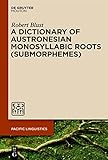A Dictionary of Austronesian Monosyllabic Roots (Submorphemes) / Robert Blust.
Material type: TextSeries: Pacific Linguistics [PL] ; 652Publisher: Berlin ; Boston : De Gruyter Mouton, [2022]Copyright date: ©2022Description: 1 online resource (IX, 279 p.)Content type:
TextSeries: Pacific Linguistics [PL] ; 652Publisher: Berlin ; Boston : De Gruyter Mouton, [2022]Copyright date: ©2022Description: 1 online resource (IX, 279 p.)Content type: - 9783110781618
- 9783110781779
- 9783110781694
- 499.2 23/ger
- PL5033 .B58 2022
- online - DeGruyter
- Issued also in print.
| Item type | Current library | Call number | URL | Status | Notes | Barcode | |
|---|---|---|---|---|---|---|---|
 eBook
eBook
|
Biblioteca "Angelicum" Pont. Univ. S.Tommaso d'Aquino Nuvola online | online - DeGruyter (Browse shelf(Opens below)) | Online access | Not for loan (Accesso limitato) | Accesso per gli utenti autorizzati / Access for authorized users | (dgr)9783110781694 |
Browsing Biblioteca "Angelicum" Pont. Univ. S.Tommaso d'Aquino shelves, Shelving location: Nuvola online Close shelf browser (Hides shelf browser)

|

|

|

|

|

|

|
||
| online - DeGruyter Die Erzeugung von Arbeit : Variationen, Unterschiede und Hierarchien von Erwerb und Unterhalt / | online - DeGruyter Täterschaft und Tatherrschaft / | online - DeGruyter Normative Bedeutung von Handlungsfolgen : Paradigmatische utilitaristische Ansätze und katholische Moraltheologie / | online - DeGruyter A Dictionary of Austronesian Monosyllabic Roots (Submorphemes) / | online - DeGruyter The Iran National Front and the Struggle for Democracy : 1949–Present / | online - DeGruyter The Qur’an with Cross-References / | online - DeGruyter The Concept of Economy in Judaism, Christianity and Islam / |
Frontmatter -- Contents -- List of abbreviations -- Introduction -- 1 Literature review -- 2 Issues relating to the root in Austronesian languages -- 3 Summary of the data -- 4 Sources for the data -- 5 The Data -- 6 Appendices -- References
restricted access online access with authorization star
http://purl.org/coar/access_right/c_16ec
This book documents an understudied phenomenon in Austronesian languages, namely the existence of recurrent submorphemic sound-meaning associations of the general form -CVC. It fills a critical gap in scholarship on these languages by bringing together a large body of data in one place, and by discussing some of the theoretical issues that arise in analyzing this data. Following an introduction which presents the topic, it includes a critical review of the relevant literature over the past century, and discussions of the following: 1. problems in finding the root (the "needle in the haystack" problem), 2. root ambiguity, 3. controls on chance as an interfering factor, 4. unrecognized morphology as a possible factor in duplicating evidence, 5. the shape/structure of the root, 6. referents of roots, 7. the origin of roots, 8. the problem of distinguishing false cognates produced by convergence in root-bearing morphemes from legitimate comparisons resulting from divergent descent, and 9. the problem of explaining how submorphemes are transmitted across generations of speakers independently of the morphemes that host them. The remainder of the book consists of a list of sources for the 197 languages from which data is drawn, followed by the roots with supporting evidence, a short appendix, and references.
Issued also in print.
Mode of access: Internet via World Wide Web.
In English.
Description based on online resource; title from PDF title page (publisher's Web site, viewed 25. Jun 2024)


